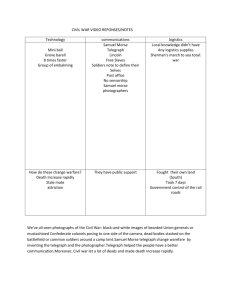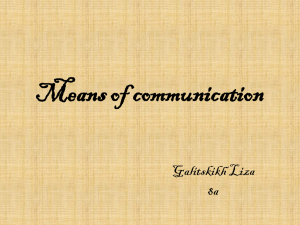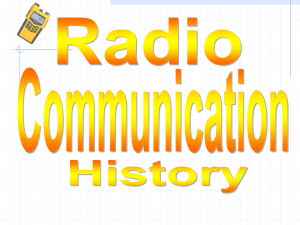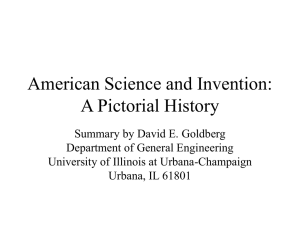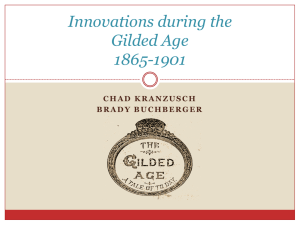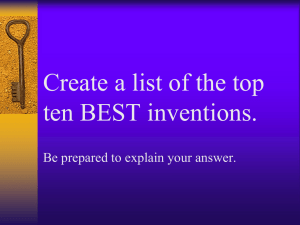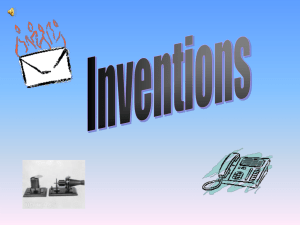industrial revolution
advertisement
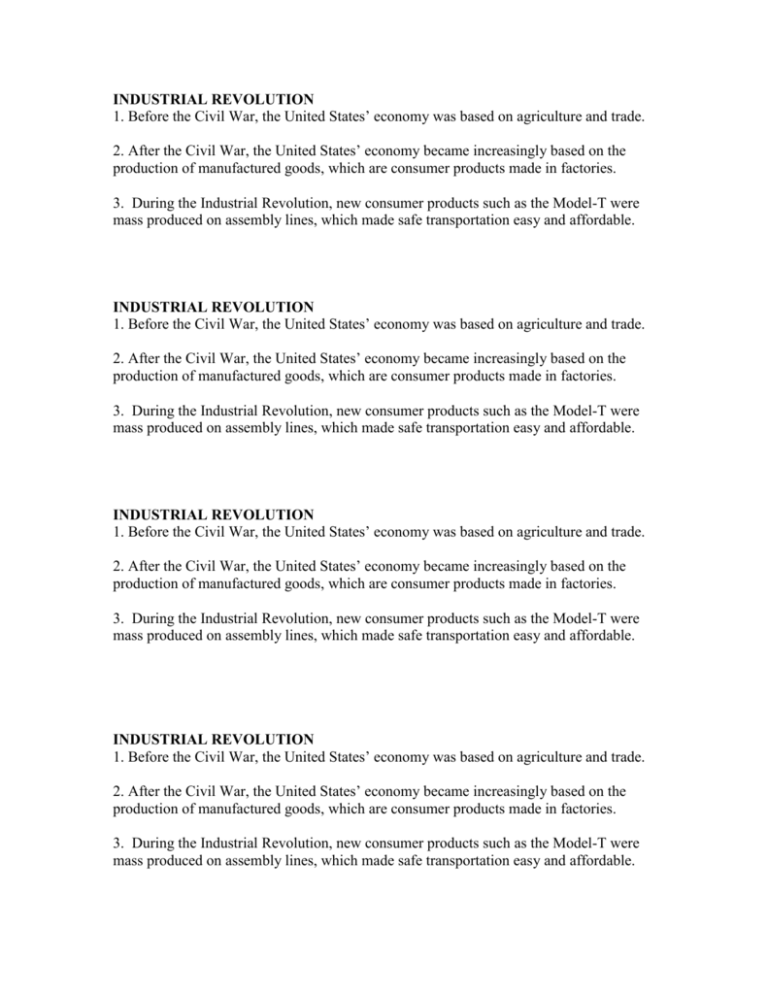
INDUSTRIAL REVOLUTION 1. Before the Civil War, the United States’ economy was based on agriculture and trade. 2. After the Civil War, the United States’ economy became increasingly based on the production of manufactured goods, which are consumer products made in factories. 3. During the Industrial Revolution, new consumer products such as the Model-T were mass produced on assembly lines, which made safe transportation easy and affordable. INDUSTRIAL REVOLUTION 1. Before the Civil War, the United States’ economy was based on agriculture and trade. 2. After the Civil War, the United States’ economy became increasingly based on the production of manufactured goods, which are consumer products made in factories. 3. During the Industrial Revolution, new consumer products such as the Model-T were mass produced on assembly lines, which made safe transportation easy and affordable. INDUSTRIAL REVOLUTION 1. Before the Civil War, the United States’ economy was based on agriculture and trade. 2. After the Civil War, the United States’ economy became increasingly based on the production of manufactured goods, which are consumer products made in factories. 3. During the Industrial Revolution, new consumer products such as the Model-T were mass produced on assembly lines, which made safe transportation easy and affordable. INDUSTRIAL REVOLUTION 1. Before the Civil War, the United States’ economy was based on agriculture and trade. 2. After the Civil War, the United States’ economy became increasingly based on the production of manufactured goods, which are consumer products made in factories. 3. During the Industrial Revolution, new consumer products such as the Model-T were mass produced on assembly lines, which made safe transportation easy and affordable. INVENTORS & SCIENTISTS 1. In the late 1800s and early 1900s, new inventions changed the way people lived and led to the rise of new industries. 2. Inventors and scientists contributed to the Industrial Revolution and helped the US to become a leading industrial and military power in the world. 3. Scientists also served as entrepreneurs by developing their inventions into businesses, which made the American economy grow strong. INVENTORS & SCIENTISTS 1. In the late 1800s and early 1900s, new inventions changed the way people lived and led to the rise of new industries. 2. Inventors and scientists contributed to the Industrial Revolution and helped the US to become a leading industrial and military power in the world. 3. Scientists also served as entrepreneurs by developing their inventions into businesses, which made the American economy grow strong. INVENTORS & SCIENTISTS 1. In the late 1800s and early 1900s, new inventions changed the way people lived and led to the rise of new industries. 2. Inventors and scientists contributed to the Industrial Revolution and helped the US to become a leading industrial and military power in the world. 3. Scientists also served as entrepreneurs by developing their inventions into businesses, which made the American economy grow strong. INVENTORS & SCIENTISTS 1. In the late 1800s and early 1900s, new inventions changed the way people lived and led to the rise of new industries. 2. Inventors and scientists contributed to the Industrial Revolution and helped the US to become a leading industrial and military power in the world. 3. Scientists also served as entrepreneurs by developing their inventions into businesses, which made the American economy grow strong. THOMAS EDISON 1. Thomas Edison was not only an inventor, but an entrepreneur who established a commercial laboratory at Menlo Park, New Jersey. 2. The inventions at Menlo Park included the phonograph and the incandescent light bulb, a clean, safe, dependable bulb. 3. Edison also built a power generating station in New York City that provided electricity first to businesses, and later to homes in the city. THOMAS EDISON 1. Thomas Edison was not only an inventor, but an entrepreneur who established a commercial laboratory at Menlo Park, New Jersey. 2. The inventions at Menlo Park included the phonograph and the incandescent light bulb, a clean, safe, dependable bulb. 3. Edison also built a power generating station in New York City that provided electricity first to businesses, and later to homes in the city. THOMAS EDISON 1. Thomas Edison was not only an inventor, but an entrepreneur who established a commercial laboratory at Menlo Park, New Jersey. 2. The inventions at Menlo Park included the phonograph and the incandescent light bulb, a clean, safe, dependable bulb. 3. Edison also built a power generating station in New York City that provided electricity first to businesses, and later to homes in the city. THOMAS EDISON 1. Thomas Edison was not only an inventor, but an entrepreneur who established a commercial laboratory at Menlo Park, New Jersey. 2. The inventions at Menlo Park included the phonograph and the incandescent light bulb, a clean, safe, dependable bulb. 3. Edison also built a power generating station in New York City that provided electricity first to businesses, and later to homes in the city. ALEXANDER GRAHAM BELL 1. Alexander Graham Bell was always interested in sound and speech, and wanted to invent a machine that would allow people to talk to each other across wires. 2. In 1876, Bell tested his “talking telegraph,” or telephone, by shouting “Mr. Watson, come here, I want to see you!” 3. Bell developed his invention of the telephone into a major corporation, Bell Telephone Company, which later became American Telephone and Telegraph, or AT&T. ALEXANDER GRAHAM BELL 1. Alexander Graham Bell was always interested in sound and speech, and wanted to invent a machine that would allow people to talk to each other across wires. 2. In 1876, Bell tested his “talking telegraph,” or telephone, by shouting “Mr. Watson, come here, I want to see you!” 3. Bell developed his invention of the telephone into a major corporation, Bell Telephone Company, which later became American Telephone and Telegraph, or AT&T. ALEXANDER GRAHAM BELL 1. Alexander Graham Bell was always interested in sound and speech, and wanted to invent a machine that would allow people to talk to each other across wires. 2. In 1876, Bell tested his “talking telegraph,” or telephone, by shouting “Mr. Watson, come here, I want to see you!” 3. Bell developed his invention of the telephone into a major corporation, Bell Telephone Company, which later became American Telephone and Telegraph, or AT&T. ALEXANDER GRAHAM BELL 1. Alexander Graham Bell was always interested in sound and speech, and wanted to invent a machine that would allow people to talk to each other across wires. 2. In 1876, Bell tested his “talking telegraph,” or telephone, by shouting “Mr. Watson, come here, I want to see you!” 3. Bell developed his invention of the telephone into a major corporation, Bell Telephone Company, which later became American Telephone and Telegraph, or AT&T. THE WRIGHT BROTHERS 1. Orville and Wilbur Wright built and repaired bicycles for a living, but in their free time, they thought about building a flying machine. 2. In 1899, the Wright Brothers built a glider, a plane with no engine that can glide on wind, and tested it at Kitty Hawk, North Carolina. 3. In 1903, their motorized airplane flew for 12 seconds, a breakthrough that started the aircraft industry. THE WRIGHT BROTHERS 1. Orville and Wilbur Wright built and repaired bicycles for a living, but in their free time, they thought about building a flying machine. 2. In 1899, the Wright Brothers built a glider, a plane with no engine that can glide on wind, and tested it at Kitty Hawk, North Carolina. 3. In 1903, their motorized airplane flew for 12 seconds, a breakthrough that started the aircraft industry. THE WRIGHT BROTHERS 1. Orville and Wilbur Wright built and repaired bicycles for a living, but in their free time, they thought about building a flying machine. 2. In 1899, the Wright Brothers built a glider, a plane with no engine that can glide on wind, and tested it at Kitty Hawk, North Carolina. 3. In 1903, their motorized airplane flew for 12 seconds, a breakthrough that started the aircraft industry. THE WRIGHT BROTHERS 1. Orville and Wilbur Wright built and repaired bicycles for a living, but in their free time, they thought about building a flying machine. 2. In 1899, the Wright Brothers built a glider, a plane with no engine that can glide on wind, and tested it at Kitty Hawk, North Carolina. 3. In 1903, their motorized airplane flew for 12 seconds, a breakthrough that started the aircraft industry. SAMUEL MORSE 1. An American inventor named Samuel Morse helped develop a way to send telegraph messages using a code called Morse code. 2. Morse invented the telegraph in order to help the railroads communicate, stay on schedule, and prevent accidents. 3. With the telegraph, people could now share news and information much more quickly than ever before. SAMUEL MORSE 1. An American inventor named Samuel Morse helped develop a way to send telegraph messages using a code called Morse code. 2. Morse invented the telegraph in order to help the railroads communicate, stay on schedule, and prevent accidents. 3. With the telegraph, people could now share news and information much more quickly than ever before. SAMUEL MORSE 1. An American inventor named Samuel Morse helped develop a way to send telegraph messages using a code called Morse code. 2. Morse invented the telegraph in order to help the railroads communicate, stay on schedule, and prevent accidents. 3. With the telegraph, people could now share news and information much more quickly than ever before. SAMUEL MORSE 1. An American inventor named Samuel Morse helped develop a way to send telegraph messages using a code called Morse code. 2. Morse invented the telegraph in order to help the railroads communicate, stay on schedule, and prevent accidents. 3. With the telegraph, people could now share news and information much more quickly than ever before. THE AUTOMOBILE 1. An electrical engineer named Frank Sprague designed the world’s first system of electric streetcars, which traveled more quickly and held more people than horsedrawn streetcars. 2. Frank and Charles Duryea built the first American car in 1893; this began the automobile industry in the United States. 3. In 1913, Henry Ford first used the assembly line in the production of automobiles, which made owning a car more affordable. THE AUTOMOBILE 1. An electrical engineer named Frank Sprague designed the world’s first system of electric streetcars, which traveled more quickly and held more people than horsedrawn streetcars. 2. Frank and Charles Duryea built the first American car in 1893; this began the automobile industry in the United States. 3. In 1913, Henry Ford first used the assembly line in the production of automobiles, which made owning a car more affordable. THE AUTOMOBILE 1. An electrical engineer named Frank Sprague designed the world’s first system of electric streetcars, which traveled more quickly and held more people than horsedrawn streetcars. 2. Frank and Charles Duryea built the first American car in 1893; this began the automobile industry in the United States. 3. In 1913, Henry Ford first used the assembly line in the production of automobiles, which made owning a car more affordable. THE AUTOMOBILE 1. An electrical engineer named Frank Sprague designed the world’s first system of electric streetcars, which traveled more quickly and held more people than horsedrawn streetcars. 2. Frank and Charles Duryea built the first American car in 1893; this began the automobile industry in the United States. 3. In 1913, Henry Ford first used the assembly line in the production of automobiles, which made owning a car more affordable.
